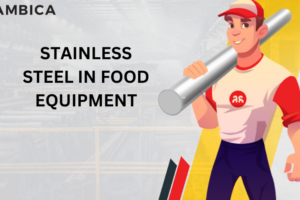304 Vs 316 Stainless steel
All steel has the same basic components that are Iron and carbon. 304 stainless steel belongs to the family of 18-8. That means chromium is about 18% and Nickel is about 8% present in this steel. It is the most commonly used steel, and it is economical too.
The different properties of 304 stainless steel are listed below.
Physical properties of 304 stainless steel :
Density- 8.00g/cm3
Melting point- 1450 Celcius
Modulus of elasticity- 193Gpa
Electrical resistivity- 0.72 ×10-6 Ω.m
Thermal conductivity- 16.2 W/m.K(Room temp.)
Thermal expansion- 17.2×10-6 /K(Room temp.)
Mechanical properties of 304 stainless steel having a thickness 8 mm sheet.
Tensile strength:
540-750 Mpa
Proof stress: 230 Mpa (min.)
Elongation: 45% (min)
Mechanical properties of 304 stainless steel having thickness 8-75 mm.
Tensile strength:
520-720 Mpa
Proof stress: 210 Mpa (min.)
Elongation: 45% (min)
Mechanical properties of 304 stainless steel having a thickness 160 mm bar.
304 stainless steel Tensile strength: 500-700 Mpa
Proof stress: 190 Mpa (min.)
Elongation: 45% (min)
304 stainless steel available in the market are listed below
304 vs 316 Stainless Steel Properties
304 Type stainless steel
It is the most used austenitic stainless steel. This steel has good forming and welding properties and also high corrosion resistance and strength.
It is mostly used in milk processing and wine-making. Apart from this, it is also used in many sectors such as pipeline, yeast pans, fermentation vest, and storage tank.
Because of high corrosion resistance and strength, it is used in sinks, tabletops, coffee pots, refrigerator, and utensils.
It is a very less reactive metal, so it is also used in chemical industries and even Marine nut, bolts, and the screw.
304L Type stainless steel
304L type stainless steel contains very less amount of carbon as compared to 304 stainless steel. Carbon percentage is about 0.03%. It contains very less amount of carbon, so it is minimized the formation of deleterious and harmful carbide precipitation during welding.
So it is used in beer-brewing and construction work. Apart from this, it is also used in wine-making, Food Industry, chemical containers and in the mining sector.
304 steel advantage and disadvantages
Advantages:
304 Steel has high corrosion resistance. So many acids and alkaline solution containers also use this steel for the production of that container.
Excellent cold and hot forming process and performance so that it is used in cold and hot both atmosphere.
It also has good weldability, so it is widely used in construction companies.
Disadvantages:
If you will use large section size steel then after sometime intergranular corrosion occurs because of welding sensitivity.
If we have a container containing water with wet air, then it is susceptible to stress corrosion.
304 stainless steel has the very poor cutting performance.
Because of these disadvantages, people are working in the production and Research and Development department just to eliminate all these problems.
316 stainless steel
316 stainless steel differs from 304 stainless steel because it contains 3% molybdenum. Because of this corrosion resistance increases and many other properties improve such as resistance in pitting in chloride ion solution and also increases strength at high temperature.
316 stainless steel properties
Mechanical Properties:
316 Stainless Steel Tensile strength (Ultimate): 580 Mpa(Max.)
Tensile strength (Yield) : 290 Mpa(Max.)
Elongation: 50%
Modulus of elasticity: 193 GPa
Charpy Impact: 105J(Max.)
Izod Impact: 129J(Max.)
Electrical Properties:
Electrical resistivity:
7.4e-005 ohm-cm
Magnetic Permeability: 1.008
316 stainless steel available in the market in two types
316 Type stainless steel:
316 stainless steel contains more carbon in it as compared to 316L stainless steel. Here ‘L’ stands for ‘Low’. It is used in the construction of exhaust manifold, Pharmaceutical and photography parts, valve and pump parts, heat exchanger, furnace, and jet engine parts. Apart from this, it is also used in pulp paper and textile industries.
316L type stainless steel:
316L type stainless steel contains a very less amount of carbon, so it minimizes deleterious carbide precipitate at the time of welding. It contains carbon of about 0.03%.
316L SS has used enough projects where a lot of welding required. It is an excellent steel for high temperature, and high corrosion uses, that’s why it is used in the construction of marine projects.
Is It Worth the Extra Cost?
You have to pay an extra cost if you use 316 or 316L stainless steel. If you have a low budget then go with 304 and 304L steel they are similar in many properties, and they have lower-priced.
304 Vs 316 stainless steel
The primary difference between 304 and 316 steel is the presence of molybdenum in 316 stainless steel. Molybdenum is used to enhance mechanical properties such as strengthening and hardening of steel in 316 stainless steel. The presence of molybdenum will also help 316 stainless steel to fight off corrosion from chlorides.
The percentage of Nickel in 316 is more as compared to 304 stainless steel, while the chromium percentage is more in 304 as compared to 316 stainless steel.
Stainless steel 316 is more expensive as compared to 304, due to high corrosive resistance against chlorides. So 316 stainless steel is widely used in those areas salt exposure is an issue.
If we will talk about the application of 316 Steel, then it is used to manufacture Marine parts, chemical and Pharmaceutical equipment, and outdoor electrical enclosures. In contrast, 304 stainless steel is used to produce wheel cover, Storage tank, kitchen equipment, and electrical cabinet.
Inshorts 316 stainless steel is expensive as compared to 304 stainless steel if you need higher corrosion resistance and your component always comes in contact with the saline and normal water then you will use 316 stainless steel. If your terms and condition violate the above condition, then use 304 stainless steel because it also serves your needs just fine.
You would anticipate that stainless steel never stains yet you would not be right; particularly in the event that you are utilizing them in a mechanical setting. Like different metals, it is affected by oil, markings, and inevitably rust. Stainless steel is no special case. Being for more than 5 decades in the stainless steel industry, we suggest all users to never pass judgment on stainless steel by its name.
Since stainless steel is utilized for numerous applications, it is built to adjust to every circumstance.
All steels have the same basic iron and carbon composition, but stainless steel also contains a healthy dose of chromium—the alloy that gives stainless steel its famous corrosion resistance.
Hence, when you evaluate stainless steel in regard to the end-user application, stainless steel becomes hard to understand. Hence, on the basis of the mixture of chemical components, stainless steel is classified by grades. Each grade is most appropriate for a specific purpose.
With regards to stainless steel, the two most ordinarily utilized grades are Grade 304 and 316.
Here’s every depiction to enable you to comprehend which one is best suited for your application.
Grade 304 is the most versatile and widely used across the globe largely due to its excellent corrosion resistance and value. In the event that you have any stainless steel food or kitchen appliances, it is likely produced using grade 304. It is also commonly used in construction, site furnishings and in decor. Grade 304 stainless steel comes with one shortcoming where we start looking for another similar grade but with this feature: it is defenseless to corrosion from marine environments or chloride solutions. Hence, 316 comes into the picture.
Grade 316 was produced with an added corrosion resistance feature in the high saline environment. It has a marginally higher nickel content, yet is recognized by the addition of molybdenum (Mb). This mixture increases corrosion resistance property, especially against chlorides and other mechanical solvents. This grade of stainless steel is determined and utilized as a part of high-saline situations and in numerous mechanical applications including preparing chemicals. Because of its non-responsive qualities, 316 stainless steel is additionally utilized as a part of the produce of surgical instruments.




